La Teste-de-Buch, Gironde, Nouvelle-Aquitaine 作者: 来源: 发布时间:2021-09-25
I.Population and Area
Total Area: 180.20 km2
Population in 2017: 26 078
Population Density: 145 /km2
Histogram of demographic change
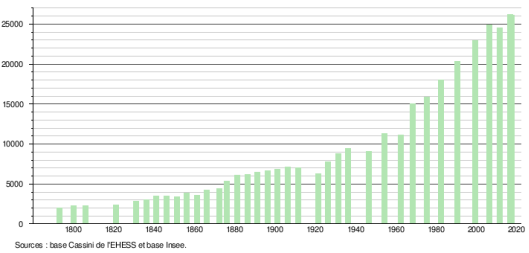
II.Natural Geography (environment and resources)
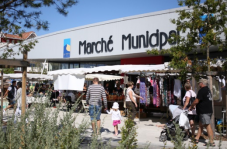
La Teste-de-Buch is a town in southwestern France, located near Arcachon in the Gironde department, in the Nouvelle-Aquitaine region. It is part of the historic region of Gascony. It is one of the largest municipalities in France in terms of surface area.
It has three urban sectors separated by a huge national forest: La Teste-Center, by far the most populated, Cazaux and Pyla-sur-Mer.
Location:
Capital of the country of Buch, located in the Gironde department in the heart of the Landes de Gascogne, La Teste-de-Buch is a town located south of the Arcachon basin, between Arcachon and Gujan-Mestras. With the waters of the Basin to the north, it limits the town of Arcachon, a former hamlet of La Teste, to the south. It borders on the Landes department.
Description:
To the west of the town, is the dune of Pilat, which continues to the south by the ocean beaches.
To the south, is the pond of Cazaux and Sanguinet, called lake of Cazaux, shared between the departments of Gironde and that of Landes.
Most of the rest of the town is made up of old dunes, covered in particular by the astonishing useless forest whose natural afforestation has changed little over the centuries. It is one of the rare natural forests of the Landes de Gascogne.
The seaside resort of Pyla-sur-Mer, the village of Cazaux, the bird island and the Banc d'Arguin belong to the municipal territory of La Teste-de-Buch.
It was in 1976 that the city ceded the Cap Ferret peninsula to the municipality of Lège. Until then, it depended on its territory, making La Teste-de-Buch one of the largest municipalities in France by area and one that had the longest maritime frontage (on the ocean and the Arcachon basin).
Sources : https://www.latestedebuch.fr/
III.Economy
Employment rate (%): 76.1 (2017)
Poverty rate by age group of the tax advisor(%): 10 (2017)
Average income per family (€):2 309 net per month (27 703 net per year)(2014)
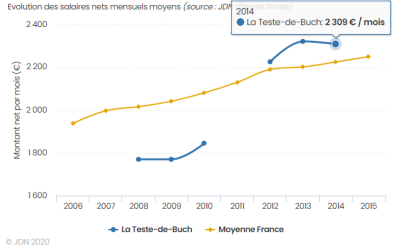
Evolution of average monthly net wages per family
Sources : http://www.journaldunet.com/business/salaire/la-teste-de-buch/ville-33529#:~:text=Les%20habitants%20de%20la%20Teste,703%20%E2%82%AC%20nets%20par%20an.
https://www.insee.fr/fr/statistiques/2011101?geo=COM-33529
IV.Industrial Characterisitics
From medieval times until the end of the 1980s, the town of La Teste lived from the exploitation of resin.
Today, the main economic activities of the town are primarily tourism, oyster farming and shipbuilding. Among the companies headquartered in La Teste-de-Buch, there are, for example, the engine designer Nanni Diesel, the Ô Sorbet d'amore ice cream parlor or the Maxicoffee coffee vendor.
The town has a delegation from the Bordeaux Chamber of Commerce and Industry.
The rise of tourism
Although already frequented by certain enthusiasts of sea bathing, Arcachon was still at the beginning of the Second Empire only a hamlet of La Teste with a few cabins occupied by fishermen and resin workers. Before 1845 and the creation of a departmental road to Arcachon, to come from La Teste you have to cross muddy salty meadows and follow a very bad sandy path. Crossings are therefore organized - by sea - from the port of La Teste, in pinnaces with sail or oars sometimes maneuvered by solid women ... At the end of 1855, the 400 inhabitants of Arcachon distributed in less than 300 villas or houses in wood (including a few shops open during the summer) request their municipal autonomy ... By the imperial decree (Napoleon III) of May 2, 1857, 759 hectares were taken from the town of La Teste to make way for that of Arcachon, finally reached by the railway on the following July 26. From 1862 the brothers Émile and Isaac Pereire got involved in the development of Arcachon, whose climate is considered exceptional by some luminaries of the medical world, in the treatment of asthma, chronic bronchitis or disorders of the nervous system [ref. necessary]. They created the Winter City for a wealthy clientele who could afford to stay there longer than only during the summer, to take advantage of the healing properties of the so-called balsamic scents of the pines and the ocean and to treat there diseases of the end of the nineteenth century.
Meanwhile, in La Teste, development remains slower and the ancestral traditions of the Pays de Buch are perpetuated away from the tourist craze: “La Teste is certainly not trivial, it is a Landes town. nestled in the hollow of an alignment of dunes, a feudal capital in full gestation. »(A History of the Basin). But the town did not remain frozen for a long time: at the start of the twentieth century during the First World War, the town of Cazaux hosted an aviation camp which had since become air base 120 "Commandant Marzac" and at the same time, exchanging several hundred he hectares of land with the State, Daniel Meller created the “Société Immobilière de Pyla-sur-Mer” occupying a territory south of Moulleau, towards the large dune still called “the Sabloney”.
From the 1950s, the city experienced a real demographic explosion and saw its traditional activities change. Shaken up by the arrival of less expensive by-products from the oil industry, the exploitation of gemstones ceased only a few years after the golden age of resin. The Lesca factory distilling the gem closes in the 1970s and despite some attempts to stimulate tapping (so-called “American-style” pruning using acid sprays) the last gemmakers left the forest in the 1980s. The sawmills closed. . The last teams of mules towing huge pines from the forest disappear. Oyster farming is beginning to lose its old charm, its slender pinnacles replaced by ferry boats and its old huts browned with coaltar, demolished in favor of modern hangars. The doubling of the old RN650 by the “expressway” quickly renamed “direct route” shortens the distance separating what becomes the “Sud Bassin” in Bordeaux and the rest of the department. In the residential districts of Pyla-sur-Mer as in the more ordinary ones that are being built on the side of Cazaux and La Teste, real estate is developing and industrial zones are expanding. However, seaside tourism remains one of the flagship activities, recognized well beyond regional limits.
Nowadays, La Teste-de-Buch remains one of the most extensive municipalities in France, not being reduced to one but to three very distinct entities which make it its wealth: the village, Cazaux and Pyla-sur- Sea. In 1976, Cap-Ferret, until then part of the municipality, was, for administrative reasons, attached to the municipality of Lège, thus giving rise to Lège-Cap-Ferret.
La Lagune beach is authorized by municipal decree for naturism.
V.Attractions
1.Saint-Vincent church

The Saint-Vincent church: place of worship since the fourteenth century, former chapel of the castle of the captives of Buch, several times enlarged and transformed to become a parish church.
2.Place Jean-Jaurès & Place Jean-Hameau
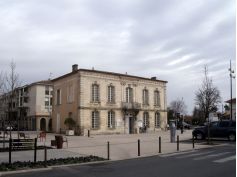
Place Jean-Jaurès: former Place du Coum, it once hosted the wooden arenas of La Teste with 5,000 places where Landes races were held.
Place Jean-Hameau: crossroads of the roads leading to Bordeaux, Arcachon, Cazaux and Le Pyla, it has gradually lost its importance over the years. It is undoubtedly the core of the village built from the sixteenth century. The concentration of ancient remains in its vicinity seems to confirm this.
3.Maison de Verthamon or Hôtel de Caupos:
rue du XIV-Juillet, this is the former town hall of La Teste-de-Buch. Property bequeathed to the town by Marie de Caupos, born June 30, 1725 in La Teste, last heiress of a Testerine family who made a fortune in the trade and export of resinous products, allowing her to buy the barony of Lacanau , the seigneury of Andernos and the viscounty of Biscarrosse. The building has been completely restored and houses the hybrid library of La Centrale. The town's war memorial is in the immediate vicinity, on the rue Edmond-Doré side.
VI.History
In the nineteenth century
As since the Middle Ages, fishing, maritime trade and logging are the main sources of income for the parishes of La Teste, Cazaux and Gujan.
The forest of La Teste is made up of two thousand-year-old massifs, similar to those we know today: the Grande Montagne in the heart of the territory of the municipality, and the Petite Montagne or Arcachon forest. These forests form the embryos which are at the origin of the Landes forest.
The remainder, made up of mobile sand dunes, continues to worry the populations living on the front of these dunes, in particular the conifers exploiting the forests of La Teste who are generally not owners of the plots where they work. Most of the time they are employed by an owner who provides them with meager resources. When their workplace is too far from the center of the town (Cazaux or La Teste) they live there with their families in wooden huts consisting of only one or two rooms, the hearth and the duct of a fireplace constituting the only masonry part of the building. It is only on Sundays or on religious holidays that these populations leave their huts to attend religious services in the village and do some shopping. Until the introduction of compulsory education, most of the inhabitants speak little or no French in favor of Gascon.
Throughout this century, the agro-pastoral system is the common lot of the moor, east of the dune fringe of the coast.
The second half of the nineteenth century, with the arrival of the railway and the improvement of the road network, provoked an increase in existing activities: it was thus possible to transport better to the sites of coal mines in the north or east of France. , posts made from young pine trunks to serve as props (woodwork) for mine galleries; the delivery of products from pine tapping such as rosin or turpentine, obtained after distillation of the resin, also benefits from improvements in transport conditions.
In addition to the village, La Teste was then made up of several districts, of unequal importance (La Seoube, Borde, Menan, Péchicq, Francon, Cap-Lande, Ninots, l'Aiguillon, etc.) with constructions made of wood for the mostly. The center of the village is located to the east of the church, on the current Place Jean-Hameau. The arrangement of the houses is not very orderly; even in the main streets the successive buildings are not always contiguous; they are separated by passages - or andrones - which allow access to the rear of the houses. Some of these are built "in hard", from stones and pebbles recovered from the unloading of passing merchant ships. Most of the rest are wood from the used forest. For the feast of Pentecost, all the dwellings have gone white in Spain, but the roads do not exist. We have been content to spread for ages a quantity of shells which are more or less crushed by the passage of people, animals or carts. Pulverized over time, the slightest breath of wind lifts them in thick clouds of dust, while with the rains we see the formation of a whitish mud making the streets impassable. The general aspect of the village gives the passing traveler an impression of poverty and desolation.
The ebb and flow of the tides penetrated deeply into the salt meadows11 and sometimes overflowed as far as the church.
The nineteenth century was the century during which many experiments took place to develop the Cazaux plain from an agricultural point of view. The Landes Exploitation and Colonization Company dug the Cazaux Canal in 1835.
It was with the construction of the Bordeaux – La Teste railway line and its opening on July 6, 1841, that the region experienced a new boom. In 1841, the train therefore reached La Teste. This event which shakes up habits and the region allows a timid opening to tourism. We then come from Bordeaux to attend the Landes races in the arenas of La Teste or Arcachon. In 1859, the station of La Teste was used as an altimetric base for the lifting of the very first general leveling of France undertaken by Paul-Adrien Bourdalouë12.
It is in 1849 that we date the beginning of oyster farming. Until then, wild oysters are collected, consumed on the spot, sometimes shipped to Bordeaux or elsewhere. Rabelais quotes “oysters from the Little Sea of Buch, with a taste of violet”. Oyster beds were then set up on the outskirts of Île aux Oiseaux before the development of spat collection by Jean Michelet, a mason from Arcachon, led to real rational exploitation. Oyster farming then spread to different places in the Basin.
A cabin on stilts is built on the outskirts of the island to monitor the parks and deter thieves. It is the ancestor of the current and world famous cabins tchanquées.
In 1857, taken from the territory of the municipality of La Teste, Arcachon is by imperial decree of Napoleon III, set up as an independent municipality; in the 1860s, the Pereire brothers created the Ville d'Hiver there.
The testins also benefited from widespread medical and health progress thanks to the research and work of Doctor Jean Hameau, precursor of Pasteur, appointed mayor of the town by Louis-Philippe from 1844 to 1848.
VII.Other information
The Local Mission
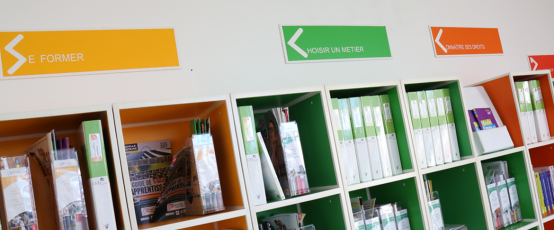
Local mission
The Local Mission of the Arcachon Basin and Val de Eyre is an association providing a public service mission to young people aged 16 to 25 who have left the school system.
If you need advice and want to move forward, the Local Mission welcomes you, informs you and supports you in the process of orientation, training, employment, housing, mobility, health.
HOW? 'OR' WHAT ?
Personalized follow-up with an advisor is offered to support you on your path to working life.
Possibility of participating in collective actions with other young people registered with the Mission Locale Haute Gironde.
With or without an appointment, you can meet an advisor depending on your place of residence.
OR ?
The headquarters of the Local Mission is located at 12, rue du Parc de l'Estey in La Teste de Buch (same building as the CCAS) but you can also be welcomed in Arcachon, Cazaux, Gujan-Mestras, Le Teich as well as on the 8 communes of COBAN and 3 communes of Val de l'Eyre near your home.
THE LOCAL MISSION IS ALSO:
Internet access and a documentary space at the head office at your disposal, for your research and your applications
An Employment service to: facilitate relations with Companies, advise Employers, disseminate their offers and put them in touch with young candidates and support young people in companies
To contact us :
05 56 22 04 22
contact@ml-ba.fr
www.facebook.com
Sources: https://www.latestedebuch.fr/economie-emploi/les-emplois/la-mission-locale/
VIII.Contact information
La Teste-de-Buch town hall address :
1 Esplanade Edmond Doré B.P. 50105 33164 La Teste de Buch Cedex
Mayor : Patrick DAVET (Mandate : 2020-2026)
Mail: mairie@latestedebuch.fr
Phone number: 05 56 22 35 00
Fax: 05 56 54 46 40
Website : https://www.latestedebuch.fr/
